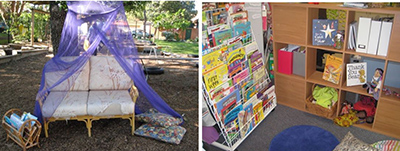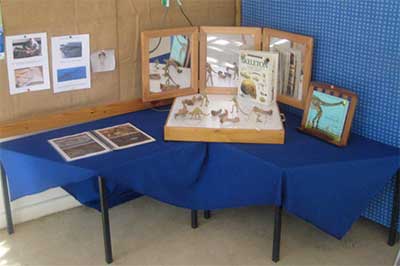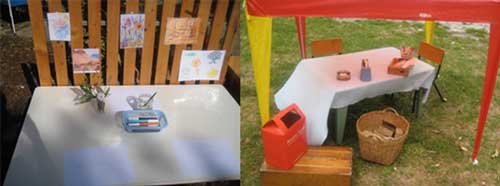Why Is an Information Intensive Classroom Important for Reading Development?
Creating a literacy-rich environment provides children with opportunities to explore and utilise literacy through their daily routines and play.
The literacy-rich surroundings is organised and so that spaces and the experiences that take place within them promote children's engagement in literacy experiences. Educators should consider environmental impress, furniture placement, and the setting upwards of literacy-rich sociodramatic play areas, as well as reading and writing areas.
The benefits of a literacy-rich environment
A literacy-rich surround provides opportunities for engaging in emergent literacy behaviours in a meaningful and authentic style. The set-upwardly of the environment allows educators to facilitate evolution of key oral language and emergent literacy skills.
As children acquire and develop, admission to print-rich environments, and contact with adults who model and respond to children's oral and written messages, proceed to strengthen the progression of learning. - VEYLDF (2016)
A literacy-rich environment demonstrates how literacy is useful in everyday life by allowing children to collaborate with print/texts independently and with educators. This helps to consolidate children's understanding of the functionality of literacy, and thus how it is useful in everyday life.
Functional and authentic contexts
Functionality and authenticity are important characteristics of a literacy-rich environment.
Educators can create an environment that is both functional and accurate by agreement children'due south interests and everyday routines, and embedding the components of a literacy-rich environment within these (VEYLDF Practice Principle: Assessment for Learning and Development).
When planning a literacy-rich environment, educators should consider the post-obit primal questions (Fellowes and Oakley, 2014):
- do the materials and tools provided contain print?
- do they provide opportunities to interact with and produce print?
- does the environment facilitate social interactions, as well as emergent writing and reading?
A literacy-rich environment should besides have into account the cultural and linguistic diversity in the grouping (VEYLDF Practice Principle: Disinterestedness and Diversity).
This could be supported through:
- texts in different languages
- opportunities for children to speak their home language
- ecology print in a multifariousness of relevant community languages.
Key components
The set-up of the environment itself is important nevertheless the use of instructional support to develop children's literacy knowledge is essential (VEYLDF Practice Principle: Integrated Instruction and Learning Approaches). When setting upwards the environment, some important components to consider include:



- furniture placement and experiences that support small grouping experiences, allowing children to converse and collaborate
- socio-dramatic play areas where children are encouraged to take on different roles within the experience (Run into sociodramatic play - emergent literacy)
- inviting reading areas where children can enjoy books independently or with others, both indoors and outdoors
- the presence of books within other experiences to exist used as a reference textile
- environmental print that is functional, authentic and informative
- providing opportunities to model volume reading to individuals, small groups and big groups
- experiences that back up volume reading, including seeking information or opportunities to listen to stories and follow forth
- experiences that support writing and cartoon through dramatic play, science applied science, applied science, arts and applied science (STEAM) experiences and the provision of interesting materials and implements.

One time a literacy-rich surround has been planned and established, it is essential that educators appoint in modelling, scaffolding, and extending of literacy concepts during interactions with children.
This can be achieved by:
- drawing children's attending to the functionality of print
- eastward.yard. when children are looking for items or putting them away, describe their attention to signs and labels they can use to assistance them.
- encouraging children to interact with texts and environmental impress
- e.g. supporting them to add to the daily agenda or select a book for the educator to read to the grouping.
Theory to practice
Environmental print plays a particularly important role in stimulating children'due south emergent reading and writing skills (Morrow, 2005). It provides authentic opportunities to develop children'south understanding of symbols and that these symbols contain a bulletin (Neumann, Hood, Ford and Neumann, 2012).
Environmental print tin also be used as a tool for educators to scaffold children'southward emergent skills by drawing their attention to information technology in their surround and using it for functional purposes (for example, labels on their bag claw).
A literacy-rich environment provides children with opportunities to employ elements of literacy in functional ways. The provision of libraries or reading areas support children to bask reading independently, or with others. Neumann and Bredekamp (2000) suggested that a separate reading expanse tin can "complement and extend children's learning from books" (p. 28).
It is also of import that these areas are inviting and then that children are fatigued to the area, this may be accomplished through the inclusion of cosy surroundings, regularly calculation new books and providing a wide range of option of literature (Hill, 2009; Neumann and Bredekamp, 2000).
Evidence base
Print knowledge, combined with early writing skills accept been shown equally predictors of later literacy accomplishment (Lonigan & Shanahan, 2009). In a review of environmental print literature, Neumann et al (2012) concluded that while it plays an important part in children's emergent literacy, information technology is the interactions with others that are essential for literacy to develop.
The use of environmental print to scaffold children's learning is effective in developing children's literacy (Neumann et al, 2012).
Gerde, Bingham and Pendergast (2015) showed correlation between the level of print in the classroom and children's writing ability. In the study involving two to half dozen children from 68 classrooms (265 children in full) the need was highlighted for teachers to not only create a print-rich environment just to ensure that information technology is functional past encouraging children to utilize the print as a reference in their play and daily routines.
This was supported past Guo, Justice, Kaderavek and McGinty's (2012) study of 30 preschool teachers and children, which also highlighted that while a literacy-rich environment has been well established in research literature, they found that information technology was the dynamic interactions between teachers and children that had the greatest effects on literacy learning (VEYLDF Practice Principle: Respectful Relationships and Responsive Engagement).
Links to VEYLDF
- Victorian early years learning and development framework (VEYLDF, 2016)
- VEYLDF Illustrative maps
Outcome 5: advice
Children collaborate verbally and non-verbally with others for a range of purposes:
- appoint in enjoyable reciprocal interactions using verbal and non-exact linguistic communication
- employ language and representations from play, music and art to share and project meaning
- contribute their ideas and experiences in play and minor and large group discussion.
Children appoint with a range of texts and get significant from these texts:
- take on roles of literacy and numeracy users in their play.
Children express ideas and make meaning using a range of media:
- employ language and appoint in symbolic play to imagine and create roles, scripts and ideas
- employ the creative arts, such equally cartoon, painting, sculpture, drama, trip the light fantastic, movement, music and story-telling, to express ideas and brand meaning.
Children begin to understand how symbols and patterns work:
- develop an understanding that symbols are a powerful ways of advice and that ideas, thoughts and concepts can be represented through them.
Experiences plans and videos
For ages: early on communicators (birth - xviii months)
- edible finger paint
- reading areas
For ages: early language users (12 - 36 months)
- reading areas
- edible finger paint
- worm farm: word around texts
For ages: linguistic communication and emergent literacy learners (30 - threescore months)
- reading areas
- worm farm: word effectually texts
- print in other languages
Links to learning foci and teaching practices:
- sociodramatic play (emergent literacy)
References
Clay, M. (2005). An observation survey of early on literacy achievement. New Zealand: Pearson Pedagogy.
Fellowes, J. & Oakley, G. (2014). Language, Literacy and Early Childhood Education, Melbourne: Oxford University Press.
Gerde, H.Thousand., Bingham, Thousand.Due east., & Pendergast, M. (2015). Reliability and validity of the Writing Resources and Interactions in Teaching Environments (WRITE) for preschool classrooms. Early on Childhood Enquiry Quarterly, 31(2), 34–46. doi:ten.1016/j.ecresq.2014.12.008
Gerde, H. Yard., Goetsch, K. Due east., & Bingham, Thousand. E. (2016). Using print in the environment to promote early writing, The Reading Teacher, seventy(three), 283-293.
Guo, Y., Justice, 50. 1000., Kaderavek, J. N., & McGinty, A. (2012). The literacy surroundings of preschool classrooms: Contributions to children'south emergent literacy growth, Periodical of Research in Reading, 35(3), 308-327.
Hill, S. (2009). Developing early literacy: Assessment and teaching, Melbourne: Eleanor Pall Publishing.
Massey, S. L. (2013). From the reading rug to the play centre: Enhancing vocabulary and comprehensive language skills by connecting storybook reading and guided play. Early Childhood Pedagogy Journal, 41, 125-131.
Morrow, L.Chiliad. (2005). Literacy development in the early years: Helping children read and write (5th ed.). Needham Heights, MA: Allyn and Bacon.
Neuman, S. B., & Bredekamp, S. (2000). 'Becoming a reader: A developmentally appropriate arroyo' In D. Due south. Strickland (Ed.) Beginning reading and writing, New York: Columbia University (pp. 22-34).Neumann, M., Hood, M., Ford, R., & Neumann, D. (2012). The Office of Environmental Impress in Emergent Literacy, Periodical of Early on Childhood Literacy, 12(iii), 231-258.
Victorian State Government Section of Education and Training (2016), Victorian early on years learning and development framework (VEYLDF) (pdf - 1.14mb), Retrieved iii March 2018.
Victorian Curriculum and Cess Authorisation (2016) Illustrative Maps from the VEYLDF to the Victorian Curriculum F–10 Retrieved 3 March 2018.
littleyouserainvid.blogspot.com
Source: https://www.education.vic.gov.au/childhood/professionals/learning/ecliteracy/emergentliteracy/Pages/literacyrichenvironment.aspx
Post a Comment for "Why Is an Information Intensive Classroom Important for Reading Development?"